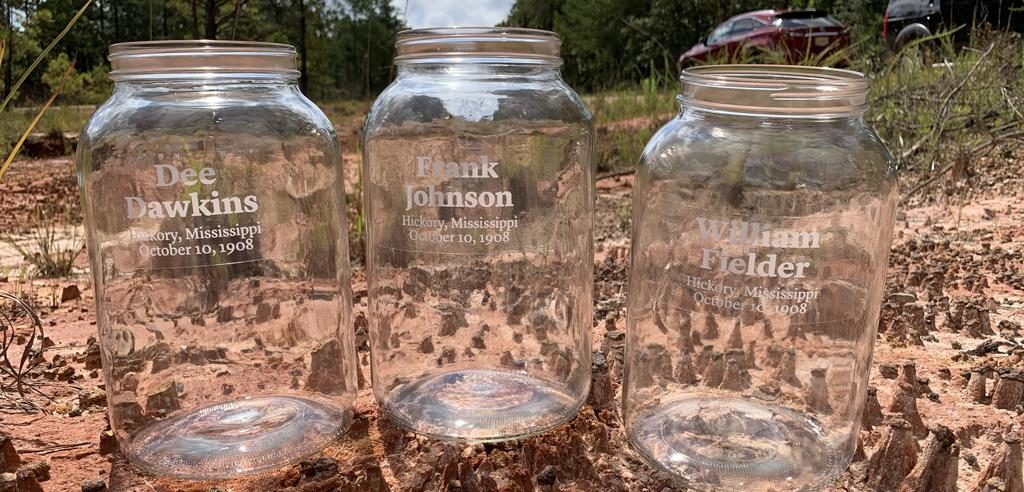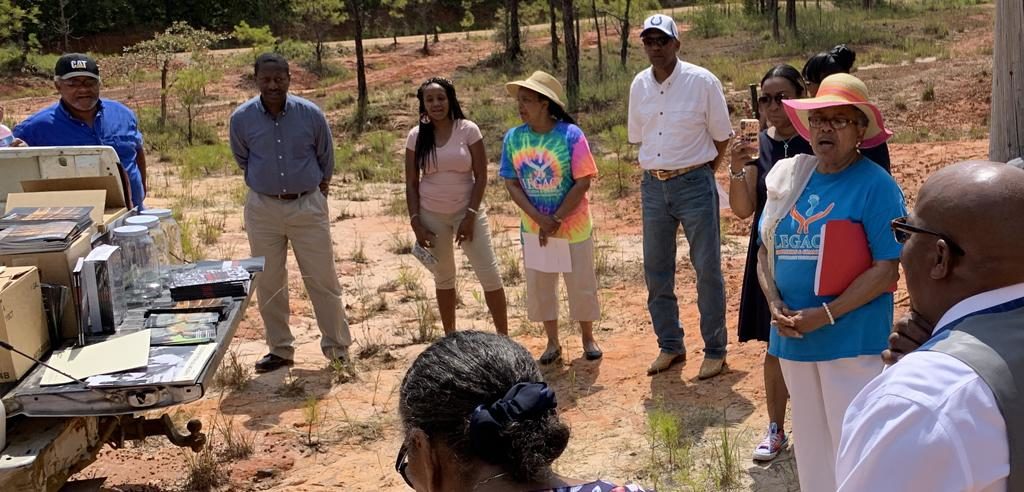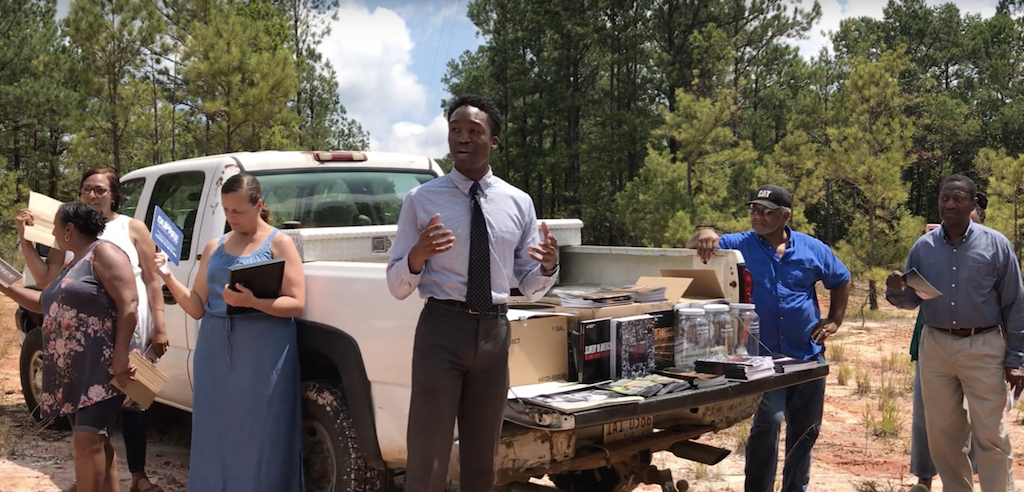Descendants of three victims of racial terror lynching in Newton County, Mississippi, joined with community members and EJI staff to collect soil from lynching sites on Saturday. A ceremony honoring the memory of Dee Dawkins, Frank Johnson, and William Fielder was part of the “Come Home to Good Hope” celebration, an annual gathering to commemorate the founding of the Good Hope Freedom Settlement by formerly enslaved persons after the Civil War.
Local historian Mrs. Joyce Salter-Johnson reached out to EJI after her grandchildren found the name of their ancestor, Frank Johnson, when they visited the National Memorial for Peace and Justice in Montgomery.
EJI spent years researching racial terror lynchings in America. We identified more than 4000 African American men, women, and children who were lynched between 1877 and 1950 and built the National Memorial to memorialize them. The memorial structure is constructed of over 800 steel monuments, one for each county in the United States where a racial terror lynching took place, engraved with the names of the victims.
After her grandchildren found Frank Johnson’s name on the monument for Newton County, Mississippi, Mrs. Salter-Johnson contacted EJI to learn more about participating in our Community Remembrance Project, which recognizes victims of lynching by collecting soil from lynching sites, erecting historical markers, and claiming monuments from the national memorial. She worked with retired judge Constance Slaughter-Harvey to organize the soil collection event and the community is now making plans to install a historical marker.
From left, Brandi Salter and Zedra Foster, descendants of Frank Johnson, and Brandy Chapman, descendant of William Fielder.
Dan Dawkins collected soil in remembrance of his ancestor, Dee Dawkins.
The Lynchings of Dee Dawkins, Frank Johnson, and William Fielder
On October 10, 1908, a mob of at least 50 white men seized and terrorized Dee Dawkins, Frank Johnson, and William Fielder simply because they were associates of Shep Jones, a Black man accused of killing a local white man. Mr. Dawkins and Mr. Johnson were later found shot to death on a public road, while Mr. Fielder – a relative of Shep Jones – was tortured and found hanging from a tree near his home. Despite reports that the three men were innocent of any offense, they died because the mob could not locate Mr. Jones.
Two days earlier, Shep Jones was accused of killing A.J. Wall, a wealthy white planter. During this era, many African Americans were lynched after being accused of murder. Mere suggestions of Black-on-white violence could provoke mob violence and lynching before the judicial system could or would act.
Undoubtedly aware that he could be killed before trial, Mr. Jones fled. News reports did not disclose what, if any, evidence supported the accusations against him. White people’s allegations against Black people were rarely scrutinized and often sparked violent reprisal even when there was no evidence tying the accused to any offense. In this environment, Mr. Jones’s flight is stronger evidence of fear than guilt.
Infuriated by Mr. Jones’s escape, a mob of white men launched a manhunt. After failing for two days to find Mr. Jones, the mob undertook “a campaign of extermination” against the entire Black community. It was not uncommon during this era for lynch mobs to target a Black suspect’s family, neighbors, or any Black people they encountered.
On the evening of October 9, while attempting to track Mr. Jones with bloodhounds, the mob came to the home of William Fielder, who was Mr. Jones’s father-in-law. When Mr. Fielder refused to disclose any information about Mr. Jones’s whereabouts, the mob brutally tortured him, eventually forcing him to implicate Dee Dawkins.
Lynch mobs regularly subjected their victims to beatings, torture, and threats of lynching to obtain confessions or information. These tactics led innocent men and women to confess to crimes they did not commit and to implicate other innocent people. After Mr. Fielder gave the mob Mr. Dawkins’s name, the white men dragged him from his home and hanged him. His body was found before dawn on October 10.
Later that morning, the mob found Mr. Dawkins and shot him to death without arrest or trial after accusing him of hiding Shep Jones. His corpse was reportedly “found dead by the roadside.”
The mob then fatally shot Frank Johnson, whose “only offense was that he was a friend of Jones.”
Mr. Fielder, Mr. Dawkins, and Mr. Johnson were later reported to have been “in no way connected with the assassination of Wall.” Their racial terror lynchings were intended to send a broader message of white domination and instill fear within the entire African American community.
According to press reports, several other Black people in Newton County were likely victims of the mob’s rampage. Near Gardlandville, a Black church and lodge hall were burned to the ground. White mobs often destroyed Black-owned property and cultural centers to terrorize members of the African American community.
In response to the violence, it was reported that many “panic-stricken” African Americans fled Newton County. Local law enforcement did little to intervene against the mob. Officers advised the governor of the situation, but did not request reinforcements or support to stop the attacks. Like many all-white systems of law enforcement in communities throughout the South, officers in Hickory, Mississippi, were indifferent to the plight of Black residents and derelict in their duty to protect them. White mobs were left free to commit violence and murder without fear of any legal repercussions.
Surviving reports do not indicate that anyone was arrested or prosecuted for the lynching of Mr. Dawkins, Mr. Fielder, and Mr. Johnson, or the intentional terrorizing of the Black community in Newton County. White mobs continued to hunt for Shep Jones for at least a month. In almost every documented case of racial terror lynching, the victims were not tried for their alleged offenses and their killers were not prosecuted.
Dee Dawkins, William Fielder, and Frank Johnson are three of at least 656 African American victims of racial terror lynching in Mississippi between 1877 and 1950, including at least six in Newton County.

/

/

/
EJI’s Community Remembrance Project
EJI’s Community Remembrance Project is part of our campaign to recognize the victims of lynching by collecting soil from lynching sites, erecting historical markers, and developing the National Memorial for Peace and Justice, which acknowledges the horrors of racial injustice.
As part of its effort to help towns, cities, and states confront and recover from tragic histories of racial violence and terrorism, EJI is joining with communities to install historical markers in communities where the history of lynching is documented. EJI believes that by reckoning with the truth of the racial violence that has shaped our communities, community members can begin a necessary conversation that advances healing and reconciliation.
Lynching in America
Thousands of Black people were the victims of lynching and racial violence in the United States between 1877 and 1950. The lynching of African Americans during this era was a form of racial terrorism intended to intimidate Black people and enforce racial hierarchy and segregation.
Lynching was most prevalent in the South, including Alabama, Arkansas, Florida, Georgia, Kentucky, Louisiana, Mississippi, North Carolina, South Carolina, Tennessee, Texas, and Virginia. After the Civil War, violent resistance to equal rights for African Americans and an ideology of white supremacy led to violent abuse of racial minorities and decades of political, social, and economic exploitation.
In an expanded edition of Lynching in America, EJI also documented racial terrorism beyond Southern borders, detailing more than 300 lynchings of Black people in eight states with high lynching rates in the Midwest and the Upper South, including Oklahoma, Missouri, Illinois, West Virginia, Maryland, Kansas, Indiana, and Ohio.
Lynching became the most public and notorious form of terror and subordination. White mobs were usually permitted to engage in racial terror and brutal violence with impunity. Many Black people were pulled out of jails or given over to mobs by law enforcement officials who were legally required to protect them. Terror lynchings often included burning and mutilation, sometimes in front of crowds numbering in the thousands.
In response to this racial terror and violence, millions of Black people fled the South and could never return, which deepened the anguish and pain of lynching. Many of the names of lynching victims were not recorded and will never be known.